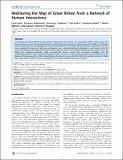| dc.contributor.author | Ratti, Carlo | |
| dc.contributor.author | Sobolevsky, Stanislav | |
| dc.contributor.author | Calabrese, Francesco | |
| dc.contributor.author | Andris, Clio | |
| dc.contributor.author | Reades, Jonathan | |
| dc.contributor.author | Martino, Mauro | |
| dc.contributor.author | Claxton, Rob | |
| dc.contributor.author | Strogatz, Steven | |
| dc.date.accessioned | 2011-06-01T14:12:50Z | |
| dc.date.available | 2011-06-01T14:12:50Z | |
| dc.date.issued | 2010-12 | |
| dc.date.submitted | 2010-07 | |
| dc.identifier.issn | 1932-6203 | |
| dc.identifier.uri | http://hdl.handle.net/1721.1/63163 | |
| dc.description.abstract | Do regional boundaries defined by governments respect the more natural ways that people interact across space? This paper proposes a novel, fine-grained approach to regional delineation, based on analyzing networks of billions of individual human transactions. Given a geographical area and some measure of the strength of links between its inhabitants, we show how to partition the area into smaller, non-overlapping regions while minimizing the disruption to each person's links. We tested our method on the largest non-Internet human network, inferred from a large telecommunications database in Great Britain. Our partitioning algorithm yields geographically cohesive regions that correspond remarkably well with administrative regions, while unveiling unexpected spatial structures that had previously only been hypothesized in the literature. We also quantify the effects of partitioning, showing for instance that the effects of a possible secession of Wales from Great Britain would be twice as disruptive for the human network than that of Scotland. | en_US |
| dc.description.sponsorship | National Science Foundation (U.S.) | en_US |
| dc.description.sponsorship | AT & T | en_US |
| dc.description.sponsorship | Audi AG | en_US |
| dc.description.sponsorship | United States. Dept. of Defense (National Defense Science and Engineering Fellowship Program) | en_US |
| dc.language.iso | en_US | |
| dc.publisher | Public Library of Science | en_US |
| dc.relation.isversionof | http://dx.doi.org/10.1371/journal.pone.0014248 | en_US |
| dc.rights | Creative Commons Attribution | en_US |
| dc.rights.uri | http://creativecommons.org/licenses/by/2.5/ | en_US |
| dc.source | PLoS | en_US |
| dc.title | Redrawing the Map of Great Britain from a Network of Human Interactions | en_US |
| dc.type | Article | en_US |
| dc.identifier.citation | Ratti C, Sobolevsky S, Calabrese F, Andris C, Reades J, et al. (2010) Redrawing the Map of Great Britain from a Network of Human Interactions. PLoS ONE 5(12): e14248. doi:10.1371/journal.pone.0014248 | en_US |
| dc.contributor.department | Massachusetts Institute of Technology. Department of Urban Studies and Planning | en_US |
| dc.contributor.approver | Sobolevsky, Stanislav | |
| dc.contributor.mitauthor | Ratti, Carlo | |
| dc.contributor.mitauthor | Sobolevsky, Stanislav | |
| dc.contributor.mitauthor | Calabrese, Francesco | |
| dc.contributor.mitauthor | Andris, Clio | |
| dc.contributor.mitauthor | Reades, Jonathan | |
| dc.contributor.mitauthor | Martino, Mauro | |
| dc.relation.journal | PLoS ONE | en_US |
| dc.eprint.version | Final published version | en_US |
| dc.type.uri | http://purl.org/eprint/type/JournalArticle | en_US |
| eprint.status | http://purl.org/eprint/status/PeerReviewed | en_US |
| dspace.orderedauthors | Ratti, Carlo; Sobolevsky, Stanislav; Calabrese, Francesco; Andris, Clio; Reades, Jonathan; Martino, Mauro; Claxton, Rob; Strogatz, Steven H. | en |
| dc.identifier.orcid | https://orcid.org/0000-0003-2026-5631 | |
| dc.identifier.orcid | https://orcid.org/0000-0001-6281-0656 | |
| mit.license | PUBLISHER_CC | en_US |
| mit.metadata.status | Complete | |
